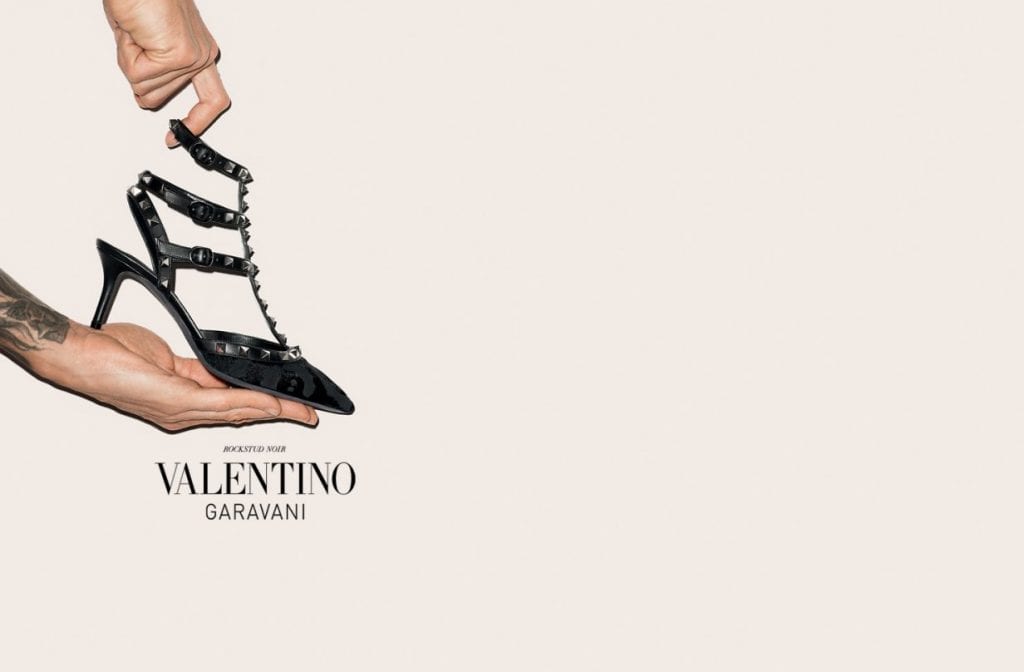Valentino is well known for putting voluminous ball gowns and intricately embroidered separates on its runways, garments that frequently transition to the bodies of major stars on major red carpets and magazine covers across the globe, but despite its dreamy ready-to-wear, the Italian fashion house, which is owned by Qatari fund Mayhoola for Investments, makes most of its money from the sale of accessories. Not just any accessories, though. Since 2010, those accessories have consisted largely of studded handbags and high heels, which fall under the umbrella of its enduring “Rockstud” range.
Writing for what was still Style.com back in March 2010, Nicole Phelps pointed to Valentino’s footwear in her review of the brand’s Fall/Winter 2010 collection, noting that “the shoes at Valentino—blush-colored patent-leather kitten heels trimmed in metal studs—are an apt metaphor for the direction Pier Paolo Piccioli and Maria Grazia Chiuri are taking the storied label.” That direction, per Phelps, meant that the former design duo were “determined to modernize [the high fashion brand] with their more dangerous, youthful sensibilities.”
The shoes would ultimately do more than “modernize” the house that Valentino Garavani founded in Rome in 1960. They would help boost its sales in a big way. The fashion media reported a few years after the studded shoes first hit the runway that Valentino’s overall sales had doubled, with sales surging by 36 percent in 2014, alone, with half of that growth attributable to accessories. A year later, the appeal of the studded heels and related accessories still had not worn off, and in fact, they were still selling out. “Since their launch in 2010, the studded heels have sold out every year,” the Independent wrote in 2015. Still yet, for the five year period ending in December 2018, Valentino’s sales had increased by nearly $1 billion, up from $590 million in 2013 to $1.4 billion at the end of 2018, and by most accounts, its robust accessories business was largely to thank.
Reflecting on the shoes five years after their initial debut, Harper’s Bazaar revealed that “nude or rouge, rainbow or leopard, leather or patent, high-heeled or flat – Valentino’s Rockstud shoes have become a closet staple in every silhouette and shade since they first hit the scene.” In other words, the Rockstud shoes firmly established themselves as the brand’s “signature” offering.
It is against that background that the brand’s legal team looked to the U.S. Patent and Trademark Office (“USPTO”) on a number of occasions between December 2010 and October 2019, seeking registrations for a number of Rockstud-related trademarks – from the “Rockstud” name and “Rockstud Spike” to the stud-specific appearance of it the studs on its Rockstud sandals to the placement of the pointy-little-studs on its Rockstud flats.
One of those applications has evolved into a multi-year fight between Valentino’s counsel and various arms of the USPTO: the application for “Rockstud Spike.”
On the heels of filing an application for registration for “Rockstud Spike” for use on bags, shoes, and clothing, Valentino was slapped with a loss. Following a small handful of preliminary refusals, an examining attorney for the national trademark body issued an official refusal to register the mark in 2018. The reason? The word “spike” is not registerable, as it “merely describes [Valentino’s] goods” – such as its handbags and footwear, which are embellished with spikes – as opposed to acting as an indicator of the source of the goods, the latter of which is the purpose of a trademark.
An examining attorney for USPTO held that the word “spike” is descriptive given that Valentino’s products have spikes on them, and thus, in order for the mark to be registered, Valentino would have to disclaim its rights in the word “spike.” (Sometimes a trademark may include one or more words regarded as merely descriptive or generic in relation to the products or services covered in a trademark application). When Valentino refused to amend its application and disclaim the word, the USPTO refused to register the mark, which prompted Valentino’s counsel to request a reconsideration, and ultimately, to appeal the USPTO’s decision to the TTAB.
In its appeal brief to the TTAB in June 2019, Valentino argued, among other things, that it should not be required to disclaim “spike” because the term is not descriptive since it “does not convey an immediate idea of the goods” in connection with which Valentino is using the mark, namely, clothing, footwear, and handbags. Instead, it is “suggestive of the goods,” per Valentino, because the USPTO’s definition of “spike” – which was cited as “a long piece of metal with a sharp point” – is not representative of the “studs” that appear in Valentino’s products.
Now, following a back-and-forth between Valentino’s counsel and the TTAB, Valentino has been handed a loss this month.
A 3-judge panel for the TTAB upheld the USPTO examining attorney’s decision to refuse to register the “Rockstud Spike” mark, asserting that the word “Spike” merely describes Valentino’s studded “Rockstud” products. In its decision dated April 15, 2020, the TTAB asserted that even if Valentino does not agree with the definition provided by the USPTO, there is an array of evidence in the market that the definition of “spike” varies, and thus, applies to Valentino’s use.
According to the TTAB, “various third-party websites, including Neiman Marcus, Google, Gucci, and Farfetched … show that third parties use the word SPIKE to describe [an array of different] embellishments or features on the types of goods identified in [Valentino’s] application.” For instance, the TTAB points to a listing for studded Prada sandals on Farfetch, which are labeled as “Prada Spike Caged Sandals,” and a pair of spike-embellished Louboutin heels on Neiman Marcus’ site, which are described as “Escapric Spike 100mm Red Sole Pumps,” among other examples.
With such products in mind, the TTAB states that Valentino’s “purses and shoes, as well as those of third parties, contain pointed metal pieces” – or spikes – that “taper to a point or edge and have an elongated shape in relation to the flat surface on which they are attached.” The TTAB panel says that Valentino’s embellishments fall within this grouping and “thus, demonstrate that ‘spike’ immediately describes a feature of [Valentino’s] goods.”
In conclusion, the TTAB states that the USPTO’s “refusal to register based on the requirement for a disclaimer of the word SPIKE is affirmed.” However, it asserts that if Valentino submits the required disclaimer of SPIKE within thirty days, “the requirement for the disclaimer will have been met and the application will proceed.” Valentino has not (yet) submitted such a disclaimer.














